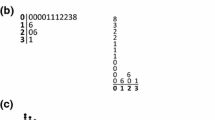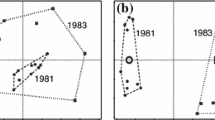Abstract
Ordination, or indirect gradient analysis, has been widely used in plant ecology as a tool for examining relationships between environment and vegetation. Since the classic work of Bray & Curtis (1957) which popularized such applications, the mathematical models underlying ordination methodology have become increasingly sophisticated. Principal Components Analysis provided increased conceptual rigor and objectivity. The realization that the assumptions of linearity implicit in PCA were not consistent with representation of nonlinear species responses along environmental gradients (Beals 1973, Jeglum, Wehrhahn & Swan 1971, Whittaker & Gauch 1973) led to introduction of a series of nonlinear methods including Reciprocal Averaging, RA, (Hill 1973, 1974), Gaussian Ordination, GO, (Gauch, Chase & Whittaker 1974, Ihm & Groenewoud 1975) and Nonmetric Multidimensional Scaling, NMDS, (Fasham 1977, Prentice 1977). Subsequent comparative studies (e. g., Fasham 1977, Gauch, Whittaker & Singer 1980) have suggested these nonlinear methods to consistently and accurately recover the structure of simulated data.
The author gratefully acknowledges the continuing collaboration of Dr. Norman L. Christensen of Duke University. This research was supported by National Science Foundation grants DEB-7708743 and DEB-7804043 to R.K.P. and DEB-7707532 and DEB-7804041 to N.L.C.
Access this chapter
Tax calculation will be finalised at checkout
Purchases are for personal use only
Preview
Unable to display preview. Download preview PDF.
Similar content being viewed by others
References
Beals, E.W. 1973. Ordination: Mathematical elegance and ecological naivete. J. Ecol. 61: 23–25.
Bray, J.R. & J.T. Curtis. 1957. An ordination of the upland forest communities of southern Wisconsin. Ecol. Monogr. 27: 325–349.
Dale, M.B. 1980. Syntactic basis for classification. In: E. van der Maarel (ed.), Advances in vegetation science: Classification and Ordination. Vegetatio 42: 111–111.
Fasham, M.J.R. 1977. A comparison of nonmetric multidimensional scaling, principal components and reciprocal averaging for the ordination of simulated coenoclines, and coenoplanes. Ecology 58: 551–561.
Gauch, H.G., G.B. Chase & R.H. Whittaker. 1974. Ordination of vegetation samples by Gaussian species distributions. Ecology 55: 1382–1390.
Gauch, H.G., R.H. Whittaker & S.B. Singer. 1980. A comparative study of nonmetric ordinations. J. Ecol. (in press).
Hill, M.O. 1973. Reciprocal averaging: An eigenvector method of ordination. J. Royal Stat. Soc., Ser. C. 23: 340–354.
Hill, M.O., R.G.H. Bunce & M.W. Shaw. 1975. Indicator species analysis, a divisive polythetic method of classification, and its application to a survey of native pinewoods in Scotland. J. Ecol. 63: 597–614.
Ihm, P. & H. van Groenewoud. 1975. A multivariate ordering of vegetation data based on Gaussian-type gradient response curves. J. Ecol. 63: 767–777.
Jeglum, J.K., C.F. Wehrhahn & J.M.A. Swan. 1971. Comparisons of environmental ordinations with principal component ordinations for sets of data having different degrees of complexity. Can. J. For. Res. 1: 99–112.
Oosting, H.J. 1942. An ecological analysis of the plant communities of piedmont, North Carolina. Amer. Midi. Nat. 28: 1–126.
Peet, R.K. & N.L. Christensen. 1979. Hardwood forest vegetation of the North Carolina piedmont. Veroff. Geobot. Inst. ETH, Stiftung Rübel, 1979 (in press).
Peet, R.K. & N.L. Christensen. 1980. Succession: a population process. In E. van der Maarel (ed.), Advances in vegetation science: Succession. Vegetatio 43.
Prentice, I.C. 1977. Non-metric ordination methods in ecology. J. Ecol. 65: 85–94.
Whittaker, R.H. & H.G. Gauch. 1973. Evaluation of ordination techniques. In: R.H. Whittaker (ed.), Ordination and classification of plant communities, p. 287–321. Junk, The Hague.
Author information
Authors and Affiliations
Editor information
Rights and permissions
Copyright information
© 1980 Dr. W. Junk bv Publishers, The Hague
About this chapter
Cite this chapter
Peet, R.K. (1980). Ordination as a Tool for Analyzing Complex Data Sets. In: van der Maarel, E. (eds) Classification and Ordination. Advances in vegetation science, vol 2. Springer, Dordrecht. https://doi.org/10.1007/978-94-009-9197-2_20
Download citation
DOI: https://doi.org/10.1007/978-94-009-9197-2_20
Publisher Name: Springer, Dordrecht
Print ISBN: 978-94-009-9199-6
Online ISBN: 978-94-009-9197-2
eBook Packages: Springer Book Archive




